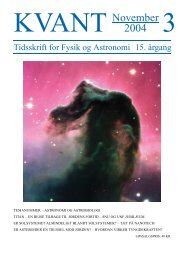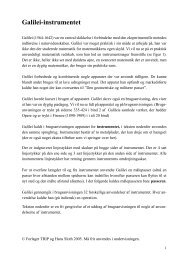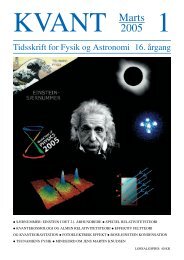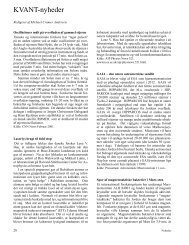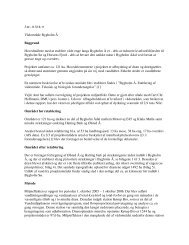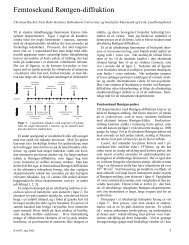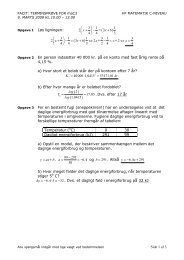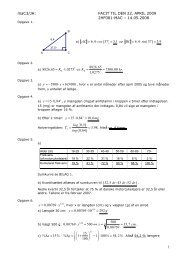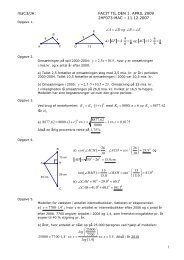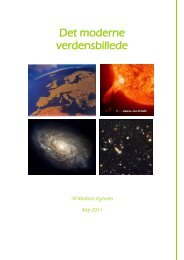Chapter 7 The Outer Planets
Chapter 7 The Outer Planets
Chapter 7 The Outer Planets
Create successful ePaper yourself
Turn your PDF publications into a flip-book with our unique Google optimized e-Paper software.
194 <strong>Chapter</strong> 7 <strong>The</strong> <strong>Outer</strong> <strong>Planets</strong><br />
86% of its atoms are hydrogen and 13% are helium. <strong>The</strong><br />
remainder consist of molecular compounds such as methane<br />
(CH 4 ), ammonia (NH 3 ), and water vapor (H 2 O). Keeping in<br />
mind that different elements have different masses, we can<br />
convert these percentages of atoms into the masses of various<br />
substances in Jupiter’s atmosphere: 75% hydrogen,<br />
24% helium, and 1% other substances. Because the interior<br />
contains more heavy elements than the surface, the overall<br />
mass distribution in Jupiter is calculated to be 71% hydrogen,<br />
24% helium, and 5% all heavier elements.<br />
<strong>The</strong> descent of the probe from the Galileo spacecraft<br />
into Jupiter’s atmosphere revealed wind speeds of up to<br />
600 km/h, higher-than-expected air density and temperature,<br />
and lower-than-expected concentrations of water, helium,<br />
neon, carbon, oxygen, and sulfur. This probably occurred<br />
because the probe descended into a particularly arid<br />
region of the atmosphere called a hot spot, akin to the air<br />
over a desert on Earth.<br />
Observations from spacecraft visiting the Jovian system<br />
and the scientific model of Jupiter’s atmosphere developed<br />
to explain these observations indicate that Jupiter has three<br />
major cloud layers (Figure 7-6). Apparently, because it descended<br />
through a hot spot, the Galileo probe failed to detect<br />
them.<br />
<strong>The</strong> uppermost Jovian cloud layer is composed of crystals<br />
of frozen ammonia. Since these crystals and the frozen<br />
water in Jupiter’s clouds are white, what chemicals create<br />
the subtle tones of brown, red, and orange? <strong>The</strong> answer is<br />
as yet unknown. Some scientists think that sulfur compounds,<br />
which can assume many different colors depending<br />
Altitude (km above 100-millibar level)<br />
200<br />
100<br />
0<br />
–100<br />
–200<br />
–300<br />
–200<br />
200<br />
Jupiter Saturn<br />
NH3 clouds<br />
NH4SH clouds<br />
H2O clouds<br />
–160<br />
–120<br />
–80<br />
–40<br />
0<br />
40<br />
80<br />
100<br />
0<br />
–100<br />
–200<br />
–300<br />
Temperature (°C) Temperature (°C)<br />
–200<br />
H2O clouds<br />
–160<br />
–120<br />
–80<br />
on their temperature, play an important role. Others think<br />
that phosphorus might be involved, especially in the Great<br />
Red Spot.<br />
Astronomers first determined Jupiter’s overall chemical<br />
composition from its average density—only 1330 kg/m 3 —<br />
which implies that Jupiter is composed primarily of lightweight<br />
elements such as hydrogen and helium surrounding<br />
a relatively small core of metal and rock. (Recall the discussion<br />
of Jupiter’s formation in Essentials II.) Jupiter’s surface<br />
and mantle are entirely liquid. Because the vast majority of<br />
Jupiter’s mass is composed of hydrogen, we cannot easily<br />
distinguish the planet’s atmosphere from its “surface.” However,<br />
at a distance of 150 km below the cloudtops, the pressure<br />
(about 10 atm) is enough to liquefy hydrogen. It was<br />
just at this distance below the cloudtops that the Galileo<br />
probe failed, presumably crushed by the high pressure of the<br />
atmosphere.<br />
In introducing the solar system, we also noted that a<br />
young planet heats up as it coalesces. After it forms, radioactive<br />
elements continue to heat its interior. On Earth, this<br />
heat leaks out of the surface through volcanoes and other<br />
vents. Jupiter loses heat everywhere on its surface, because,<br />
unlike the Earth, it has no landmasses to block the heat loss.<br />
As the heat from within Jupiter warms its liquid mantle,<br />
blobs of heated hydrogen and helium move upward. When<br />
these blobs reach the cloudtops, they give off their heat and<br />
descend back into the interior. (<strong>The</strong> same process, convection,<br />
drives the motion of the Earth’s mantle and its tectonic<br />
plates, as well as soup simmering on a stove.) Jupiter’s rapid,<br />
differential rotation draws the convecting gases into bands<br />
NH 3 clouds<br />
NH4SH clouds<br />
–40<br />
0<br />
40<br />
80<br />
FIGURE 7-6 Jupiter’s<br />
and Saturn’s Upper Layers<br />
<strong>The</strong>se graphs display<br />
temperature and pressure profiles of<br />
Jupiter’s and Saturn’s upper regions, as<br />
deduced from measurements at radio and<br />
infrared wavelengths. Three major cloud<br />
layers are shown in each, along with the<br />
colors that predominate at various depths.<br />
Data from the Galileo spacecraft indicate<br />
that Jupiter’s cloud layers are not found at<br />
all locations around the planet; there are<br />
some relatively clear, cloud-free areas.<br />
WEB LINK 7.5<br />
3




